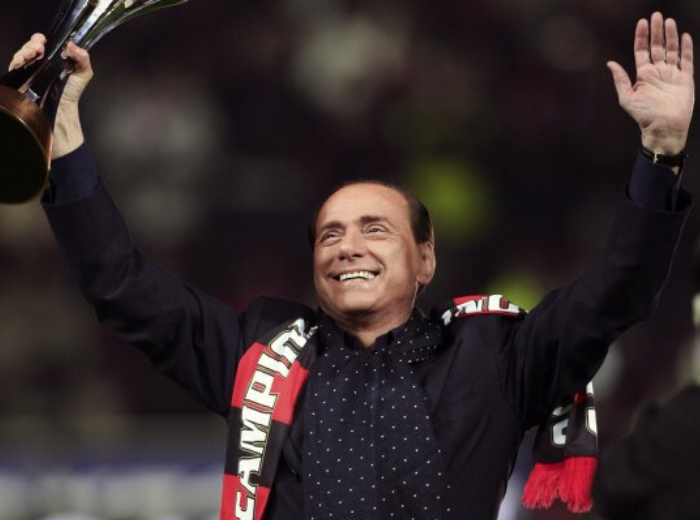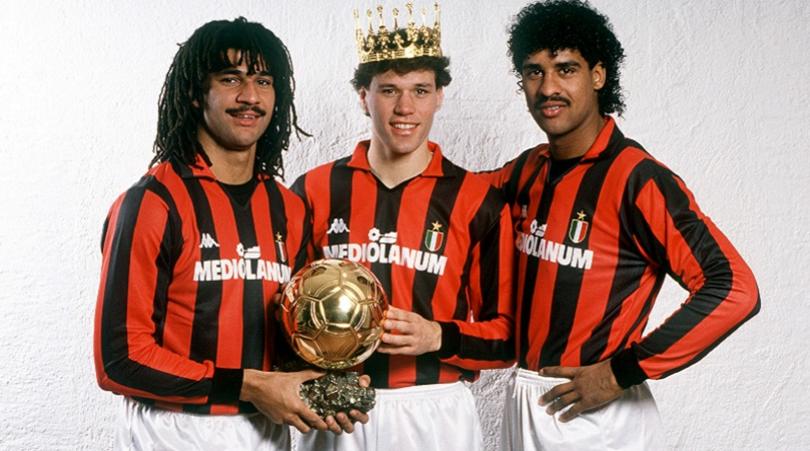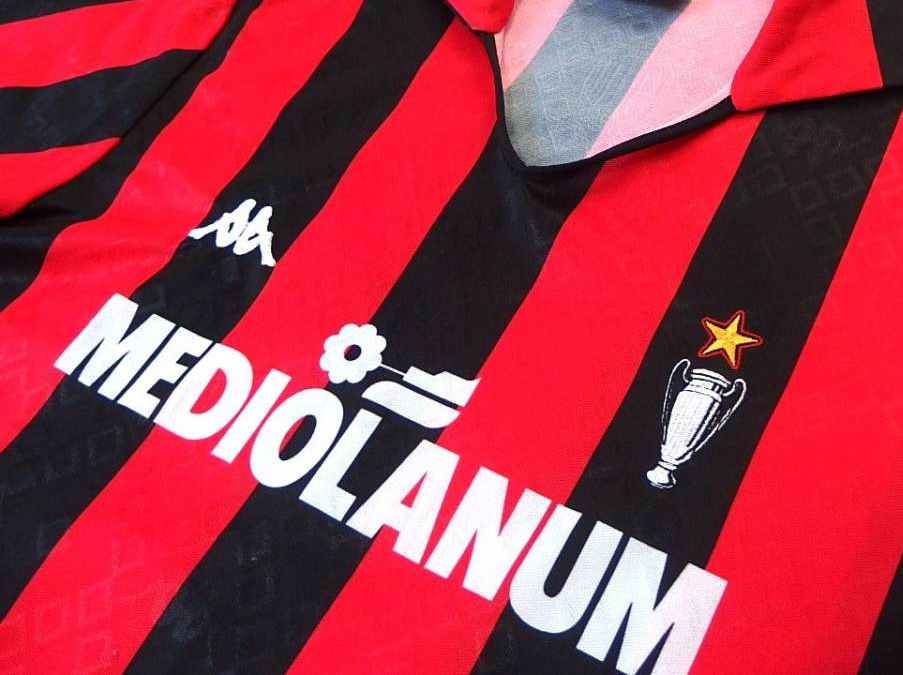Shirt: AC Milan
Seasons: 1987-92
Manufacturer: Kappa/Adidas
Sponsor: Mediolanum
Worn by: Ruud Gullit, Marco Van Basten, Frank Rijkaard, Franco Baresi, Paulo Maldini, Roberto Donadoni, Alessandro Costacurta, Carlo Ancelotti, Mauro Tassotti, Angelo Colombo, Alberigo Evani, Marco Simone.
What makes for a good football strip? A number of things, but distilled to its essence there are four primary concerns: colour, array, trim, fit. Colour can be problematic as it can’t really be tinkered with (unless your team’s majority shareholder has other ideas). The array – or pattern, if you prefer – tends to be more mutable, although radical alterations may invoke the ire of any football club’s loyal fanbase. Embellishments, such as those to the collar and neckline, will vary from season to season, normally without so much as a raised eyebrow. Finally, the way a kit is cut will only ever come under close scrutiny if it’s noticeably out of keeping with prevailing trends – for example, the shirt that Kappa presented to the Italian national team for the 2000 UEFA European Championship, which had the players so spooked they insisted on sizing up.
But wait, there’s something else to consider, something that football purists would rather wasn’t there, but is so we must: the football team’s sponsor writ large across the chest. It might seem odd that something as ostensibly functional as text should amount to anything more than a mere distraction, until one remembers that such monograms were in the first instance designed to hold the eye. This is one of the reasons why the football shirts AC Milan wore from 1987 through to 1992 are superior to those that came immediately before and after.
The AC Milan of the early 1980s was in bad shape. Saddled with debt, they’d not won a major trophy since their Serie A triumph of 1978/79 and had been relegated to Serie B twice (once as punishment for their involvement in the Totonero match-fixing scandal of 1980) which for a club of AC Milan’s standing represented failure (not to say ignominy). That being said, the thinly striped jerseys they played in during this period looked pretty good, especially the Oscar Mondadori sponsored edition that the English paring of Ray Wilkins and Mark Hateley had the pleasure of wearing in 1984/85. Whether this woollen sark was particularly comfortable is another matter.
Then in 1986, the media tycoon, politician, and former crooner, Silvio Berlusconi decided to buy the club, paid off its debts and set about the business of reviving its fortunes. Within a year he’d offloaded Wilkins and Hateley and added the Dutch internationals Ruud Gullit and Marco Van Basten to a squad that already contained the likes of Franco Baresi, Roberto Donadoni, Pietro Virdis, Mauro Tassotti and a youthful Paulo Maldini. Only then did Silvio Berlusconi consider who he wanted as coach, sacking the incumbent Nils Liedholm in April and appointing Fabio Capello as caretaker while he made up his mind. More than likely, Berlusconi had Arrigo Sacchi’s card marked from the moment his team dumped AC Milan out of the Coppa Italia in the second round. By the summer, the former Parma manager was in charge and proceeded to bring in Carlo Ancelotti from Roma and Angelo Colombo from Udinese.

Silvio Berlusconi: AC Milan’s great conductor
AC Milan won the league in 1987/88 by a three point margin over reigning champions Napoli. They did this wearing a jersey provided by Kappa that was quite different to the one they were supplying to Juventus over in Turin. Made from polyester, rather than cotton, the Milan version had a shorter collar and a shallower neckline. Moreover, whereas the sponsor’s name on Juve’s kit was flocked, on Milan’s it was printed by way of a process known as dye-sublimation. (It should be noted that Italian sportswear manufacturers were behind the curve in this respect, and I wonder whether Berlusconi might have recognised this and persuaded Kappa to utilise more up-to-date methods.) Then there was the sponsor itself – financial servicing firm Mediolanum – with its name written in a sans-serif, uppercase font and the company logo hovering above, all in white. This simple text, resting neatly beneath the Kappa logo sewn to the right and a gold star (denoting 10 titles won) on the left, is almost as recognisable as the colourway of the strip itself; one cannot conceive of the shirt without it.
In 1988 the Italian football authorities allowed for an extra foreign player, and Frank Rijkaard was invited to join his fellow Dutchmen in Milan. All three of them had been instrumental in helping The Netherlands win the 1988 UEFA European Championship in Germany over the summer. With the scudetto now adorning their chests, they must have felt a million dollars.
The 1988/89 season didn’t go entirely to plan. City rivals Inter won the title, and comfortably so, whereas AC finished third behind Napoli. But Serie A was no longer Berlusconi’s priority. He’d made it quite clear that the European Cup was what he was paying for, and in that regard the season was a huge success. Despite wobbling against Red Star Belgrade in the second round, the rossoneri went on to beat Steaua București 4-0 in the final. Perhaps even more revealing was the 5-0 demolition job they did on Real Madrid in the second leg of the semi-final.

Milan’s Dutch trio posing for a photo in 1989 with Van Basten’s Ballon d’Or award
Ostensibly, AC Milan’s strip remained the same for the following year’s campaign, but there were a few subtle changes. As with Juventus, Kappa still didn’t feel the need to append anything like a club crest (although they afforded Sampdoria the privilege), but they did see fit to attach an embroidered, celebratory image of the European Cup in place of the previous season’s scudetto. Then there was the material itself, which now incorporated a micropatterned matrix made up of hollow, inverted squares. (Juventus’s shirt received the same treatment, but not Sampdoria’s.) AC Milan finished 1989/90 second in the league, again behind Napoli, and retained the European Cup, beating Benfica 1-0 in Vienna.
In 1990 AC Milan ended their association with Kappa and signed a contract with Adidas. Under normal circumstances I’d finish this article here but the shirt Adidas came up with was so similar to Kappa’s that I feel compelled to go on. Adidas didn’t have much of a presence in Italy at the time so maybe they didn’t feeling like making too much of statement. They didn’t even bother adding their name beneath their – admittedly, instantly identifiable – trefoil logo. The micropatterning was removed and the neckline trimmed, but in every other respect the jersey was very much the same: same colour, same collar, same width of stripe, same patron, same embroidered European Cup motif.
The move to Adidas did not immediately pay dividends. AC Milan were Serie A runners-up for a consecutive season – this time trailing Sampdoria – and were knocked out of the European Cup by Marseille in the quarter-finals. (Arrigo Sacchi subsequently accepted an offer to manage the Italian national team, and Fabio Capello was appointed in his place.) This meant that for 1991/92 AC Milan’s shirt would for the first time in three years be reduced to displaying a solitary star.
Or it would have had they not decided to fill the void with a depiction of the Intercontinental Cup that they’d won the year prior, positioned beside the star rather than under it. When Red Star Belgrade beat Chilean side Colo-Colo in December to claim the same trophy, AC were obliged to get rid of it. Instead, they saw out the season with club crest attached to the jersey. By May, the rossoneri had been crowned champions again, unbeaten and eight points clear of second placed Juventus.
Italian confectioner Motta succeeded Mediolanum as club sponsor and the year after Italian sportswear manufacturer Lotto wrestled control from a reticent Adidas. ‘Motta’ lacked the graphic subtlety of ‘Mediolanum’, whereas Lotto relied too heavily on dye-sublimation, refusing to sew key details into the fabric the way their predecessors did – be it the Kappa or Adidas logos, the scudetto, the European Cup, that solitary star – which made their shirts look cheap.
But five years in pretty much the same shirt was good going, even back then. If you had to narrow it down then the Kappa version probably edges it over Adidas’s effort – the 1988/89 iteration in particular, with the scudetto contrasting nicely against the red and black stripes of AC Milan. In any case, Arrigo Sacchi’s team more than lived up to the standard this iconic top conferred upon them.
Words by James Evans: @JDEvans75
For vintage and match-worn Milan shirts click here


